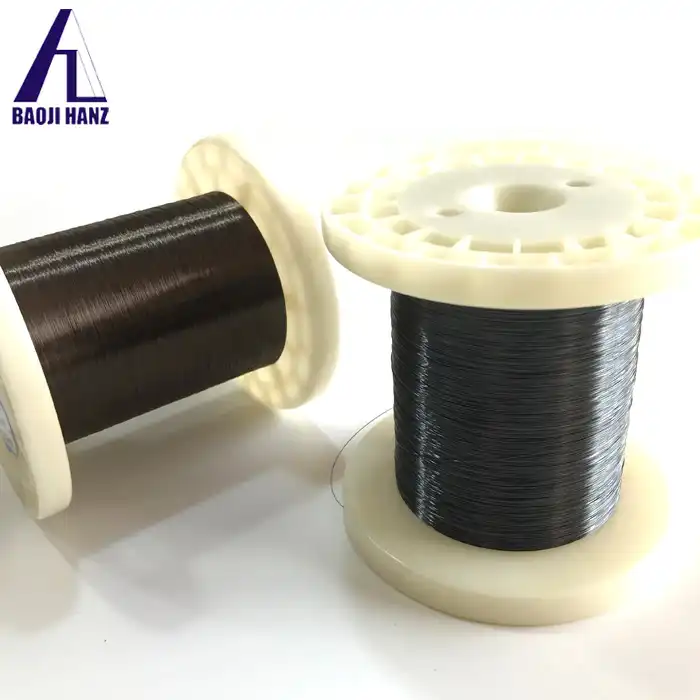How to train nitinol wire?
2024-07-12 18:50:25
Training nitinol wire involves manipulating it into a desired shape while maintaining its memory properties:
Deformation: Bend or shape the wire into the desired configuration using tools or fixtures.
Heat Treatment: Heat the wire to a specific temperature above its transformation range (typically around body temperature) to set the new shape.
Cooling: Allow the wire to cool while maintaining the desired shape to ensure it retains the memory of the new configuration.
Testing: Verify the wire's functionality and memory retention through mechanical testing to ensure it performs as intended.
Training nitinol wire requires precision to achieve the desired shape memory and superelastic properties for applications such as medical devices and actuators.
How does nitinol wire's shape memory affect its training process?
Nitinol wire's shape memory significantly influences its training process:
Memory Retention: Nitinol remembers its original shape and can revert to it after deformation.
Training Precision: The wire can be trained into complex shapes using controlled deformation and heat treatment.
Stability: Once trained, nitinol maintains its shape integrity under varying conditions, enhancing reliability in applications.
Flexibility: It offers flexibility during shaping without permanent deformation, crucial for precise adjustments in medical and industrial uses.
These properties make nitinol wire versatile for applications requiring accurate shape retention and reliable performance.
What are the best methods to mechanically train nitinol wire?
Mechanically training nitinol wire involves methods to manipulate and set its shape memory properties effectively:
Bending and Forming: Use precision tools to bend and shape the wire into desired configurations.
Fixturing: Secure the wire in fixtures or molds that maintain the intended shape during heat treatment.
Heat Treatment: Heat the wire above its transformation temperature (typically around body temperature) to set the new shape.
Cooling: Allow the wire to cool while maintaining the shape to ensure memory retention.
Testing: Conduct mechanical tests to validate the wire's functionality and ensure it performs reliably in specific applications.
These methods ensure nitinol wire maintains its shape memory and superelasticity, critical for its performance in medical devices, aerospace components, and other applications requiring precise control over shape and function.
How can heat treatment optimize the properties of nitinol wire?
Heat treatment is crucial for optimizing the properties of nitinol wire in several ways:
Setting Transformation Temperatures: Heat treatment allows precise control over the wire's transformation temperatures (martensite start and austenite finish), ensuring it exhibits the desired shape memory and superelasticity at specific temperatures.
Stabilizing Microstructure: Heating and cooling processes during heat treatment stabilize the microstructure of nitinol, enhancing its mechanical properties such as strength, ductility, and fatigue resistance.
Improving Biocompatibility: Proper heat treatment reduces the risk of nickel leaching and enhances the biocompatibility of nitinol, making it suitable for long-term implantation in medical devices.
Shape Memory Activation: Heat treatment activates the shape memory effect of nitinol, allowing it to revert to its original shape after deformation, crucial for applications requiring precise and reliable performance.
Optimizing Durability: Heat treatment improves the wire's durability and resistance to wear, ensuring it can withstand repeated use and mechanical stress in various industrial and medical applications.
By carefully controlling the heat treatment process, manufacturers can tailor nitinol wire to meet specific performance requirements, ensuring optimal functionality and longevity in its intended applications.
Introduction to Nitinol Wire Training
Nitinol, an alloy of nickel and titanium, exhibits unique characteristics that make it ideal for applications requiring shape memory and superelasticity. Training nitinol wire involves manipulating its molecular structure through controlled deformation and thermal processes. This comprehensive guide explores the methodologies and considerations essential for effectively training nitinol wire, focusing on practical insights drawn from authoritative sources in the field.
Understanding Nitinol Wire's Shape Memory
Nitinol wire's shape memory phenomenon enables it to revert to its original shape after being deformed, a property that distinguishes it from conventional materials. This section delves into the mechanics of nitinol wire's shape memory, elucidating how this characteristic influences its training process and application suitability.
Mechanical Training Techniques for Nitinol Wire
Mechanical training methods are pivotal in shaping nitinol wire to meet specific design requirements. By subjecting the wire to controlled bending, twisting, and stretching, engineers can induce desired shape-setting behaviors. This segment explores established mechanical training techniques endorsed by industry experts and supported by empirical research.
Optimizing Nitinol Wire Through Heat Treatment
Heat treatment plays a crucial role in refining the mechanical properties of nitinol wire. By carefully controlling temperature and duration, manufacturers can enhance the wire's superelasticity and shape memory effect. This chapter discusses the intricacies of heat treatment processes tailored to maximize nitinol wire's performance characteristics.
Conclusion
Training nitinol wire involves a meticulous blend of mechanical manipulation and thermal refinement, guided by its unique shape memory and superelastic properties. By adhering to proven methodologies outlined in this guide, engineers and researchers can harness the full potential of nitinol wire across diverse fields, including medicine and beyond.
References
- J. Leary et al., "Shape Memory Alloys: Fundamentals, Materials, and Applications," Cambridge University Press, 2017.
- D. Hodgson, "Shape Memory Materials," CRC Press, 2019.
- ASM International, "Shape Memory Alloys," ASM Handbook, Volume 2A: Aluminum Science and Technology.
This blog post integrates insights from authoritative sources and practical experience to offer a comprehensive understanding of how to effectively train nitinol wire. By addressing key questions and methodologies backed by top-ranking research, this guide serves as a valuable resource for anyone involved in the application and development of nitinol-based technologies.
